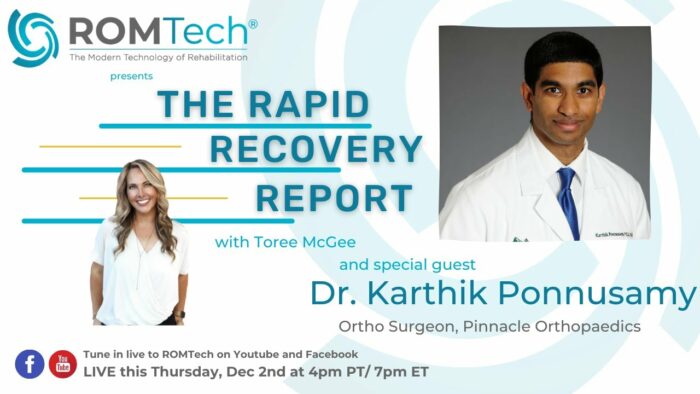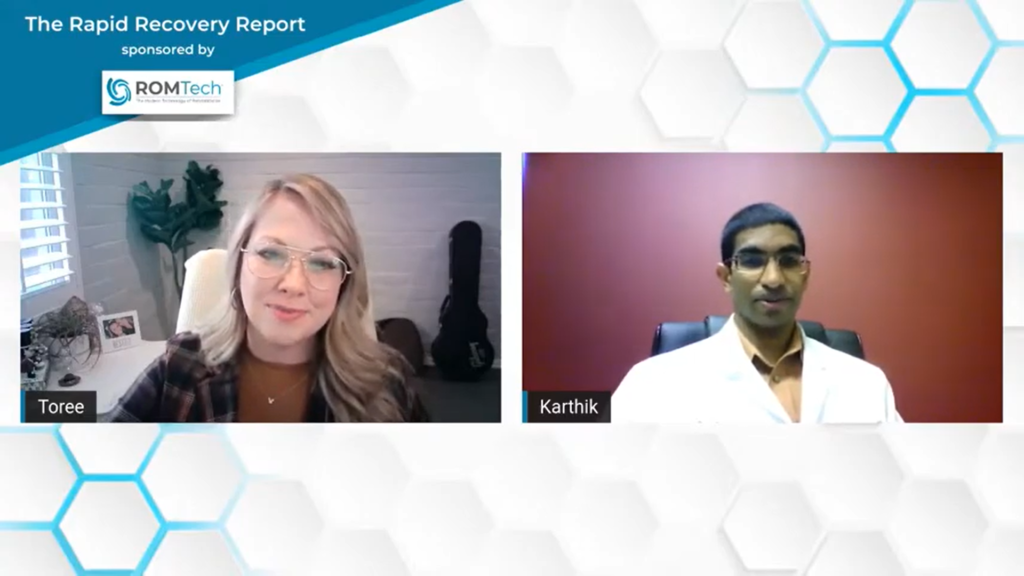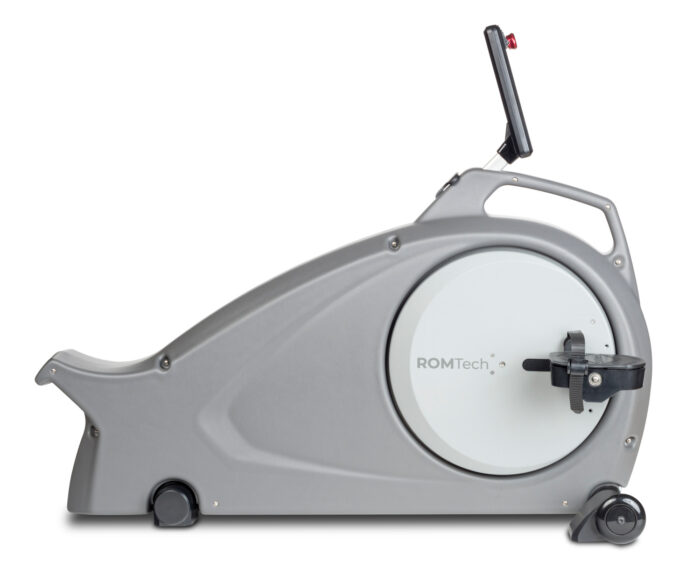Engineering a New Knee with Dr. Ponnusamy
- Comment
Toree: Hi, I’m Toree McGee, and this is The Rapid Recovery Report, sponsored by ROMTech, the modern technology of rehabilitation. So, we’ll be doing this series every other Thursday at 4:00pm Pacific, 7:00pm Eastern, and we’re going to talk to different guests, surgeons, patients, insiders here at ROMTech to discuss wellness, health, and touch a little bit on ROMTech’s PortableConnect.
So, if you’re new to ROMTech, this is your first time checking us out here, we have a pretty cool little product called the PortableConnect. There she is. Isn’t she cute? It’s a high-tech recovery device, and it’s geared at getting patients moving and recovering faster from surgeries and injuries. So, if you want to learn more about that and about us, you can visit us at Romtech.com, and you can follow us on the social media handles below in the description.

Orthopedic Surgeon, Karthik Ponnusamy
And we’ve got a really exciting guest today. So, Dr. Karthik Ponnusamy is a board-certified orthopedic surgeon, and is fellowship-trained in hip and knee replacements. He specializes in arthroscopy, hip and knee conditions, total and partial knee replacements, total hip replacements, including the direct anterior approach, robotic knee replacements, arthroplasty, and general ortho.
Dr. Ponnusamy received his medical degree from Stanford University, following a master of science degree and a bachelor of science degree both in biomedical engineering, with honors, from Johns Hopkins University. Then he completed his residency in orthopedic surgery also from Johns Hopkins. And after residency, he completed a hip and knee replacement fellowship at the University of Western Ontario. So, during his fellowship, he received additional training for the master of science in surgery.
You’ve done a whole heck of a lot, Dr. Ponnusamy, and we’re really excited to have you with us today.
Dr. Ponnusamy: Thank you very much.
Toree: Yeah, absolutely. Now, we usually like to open up our show and learn a little bit more about our guests, and it’s a little bit of an ortho surgeon ice breaker to kind of get to the heart of why it is that you chose orthopedics above all the other medicine. So, what attracted you to the field of ortho?
Dr. Ponnusamy: As you explained in the introduction, like I did my undergraduate and masters in biomedical engineering, so I had a very quantitative mechanical type of training and interest. And during undergraduate time, I had the chance to do some shadowing in cardiac surgery and some other surgeries, so that’s what led me to eventually go to medical school, and why I went into medical school expecting to do some kind of procedural, surgical type specialty, and orthopedic just had that. It was the most mechanical and most intuitive for me, and it just resonated with me, and that’s how I ended up doing it.
Toree: So, if you weren’t an ortho, you’d probably be some kind of an engineer.
Dr. Ponnusamy: Yeah, either that, or I’m not sure what other surgery I might ended up doing.
Toree: Now, you had mentioned before when we spoke that you were drawn to the engineering aspects of performing joint replacements. So, there’s an overwhelming amount of technology out there that’s helping ortho surgeons do their job a lot more efficiently and a lot more accurately. So, can you talk us through some of the latest tools that you’re particularly excited about?
Dr. Ponnusamy: Do you mind if I just step back to go historically how knee replacements were done like 30, 40 years ago when they were first done?
Toree: Okay, I love this. Yeah, let’s do it.
Dr. Ponnusamy: Back then, before all the hand-tools that we use now, it more or less was like a surgeon – I mean, this is very much simplifying things, but more or less, a ruler, and they just take us on, cut the bone in what they thought look like the right spot, and then they put the replacements in.

Somewhere around the 80’s, there’d been advances in the hand-tools in terms of the tools – I mean, you can sort of compare it to a carpenter in terms of the odd tools they have, and the different jigs they have to try and get the right angles easier and more consistently. So, that had become standard of care in the 80’s and up until recently.
Now, the next level of that is with hand-tools, they marked off every millimeter. You can’t quite go half a degree or half a millimeter, or at least get consistent reproducible measurements at that level. So, that’s why a computer assisted robotic surgery has come up as the next level, where you use a robot using image guidance, whether computer assisted or robotic, you can get even finer measurements of both thicknesses and degrees for what you’re trying to achieve.
Toree: Okay. I mean, it’s so interesting to learn about different things that you consider when you’re reengineering someone’s knee.
Dr. Ponnusamy: Yeah. The thing is that when people think a knee replacement is a knee replacement, everyone’s knee is actually different. And even the same person, for a lot of them, if people come back because they have it in both knees, even between knees, sometimes, one knee is bowed one way, the other knee is bowed the other way, and then you need to still get the knee straight on both sides.
Computer-Assisted Robotics in the OR
Toree: That’s crazy. So, what are some of the pros and the cons in using computer-assisted robotics in the OR?
Dr. Ponnusamy: So, the big pros are you can, in theory, get better accuracy, more reproducible results, and a lot of the data does support that. A lot of studies show that X-rays are more consistent in terms of what are target we’re aiming for, and staying within that target zone, compared to trying to do it with hand-tools, just because with hand-tools, you’re measuring all people’s legs, feeling different landmarks on their bones, and people’s legs come in different sizes and shapes. And in some cases, it’s harder to feel those same landmarks. So, it’s a wider spread of what the final outcome might be.
And then by having that, the theoretical advantages, oh, you’re getting in more in the right spot, you should get better outcome, that’s much more controversial. It has not been clearly born out in the research. Some studies do show some improvements with outcomes. Some studies do not show any difference. So, that’s to be remained seen. But there’s no question that accuracy is much better with the robot or computer assisted techniques.
Toree: Okay. I mean, do most of your joint replacements then go with robotic route?
Dr. Ponnusamy: Mine or in the nation?
Toree: Yours, yours specifically.
Dr. Ponnusamy: Mine, at least for the last year, vast majority are being done robotically. I mean, I didn’t go into the cons.
The main cons are it does take more time, and then there’s the level of the robot. It’s another tool you have to rely on, and how much faith do you believe in what its reading. Then I’ll trust what I see and what I measure over the robot, because I mean it’s a computer. Computers have glitches.
From my experience, I made a switch to robotics surgery about a year ago, and the vast majority of my knee replacements have been getting with the robotics knees. And generally, it seems like patients are more consistently doing better, faster. It’s not a controlled study. I had some other odd changes in my rehab protocol. We’ll get there later in terms of, back in March, I started using the PortableConnect as well for all my knee-replacement patients, so it’s hard to pinpoint which change led to these improvements.
Toree: It’s interesting you mentioned that it takes longer for robotics. Typically, a non-surgery person, who isn’t really well versed in this stuff, you would think, oh, robotics, it’s supposed to help things move along a little bit faster, so it’s interesting that it does actually take longer.
Dr. Ponnusamy: Yeah, it’s just there’s time to set up the robot, time to calibrate the robot that you wouldn’t have to do if you’re not using it.
Toree: Yeah, okay, that makes sense. So, knee surgeries are historically known to have nightmare trauma stories, how horrible it is to recovery from a really painful surgery. Today, we’ve got less invasive procedures and advanced technology and tools in the OR, and we’ve seen a lot of patients actually being discharged the very same day as surgery. So, there’s this stigma that’s still around about the difficulty of joint replacement, which is still painful, it’s still a major surgery, but how are you combating the stigma to encourage more folks to pull the trigger, and improve they’re in quality of life with a joint replacement?
Dr. Ponnusamy: I think the community as a whole, at least in this area, they’re seeing that it easier than it was in the past. Part of it is the pain control, how pain medicine regiment and anesthesia that we’re using longer-lasting pain medicines, and more importantly, longer-lasting nonnarcotic pain medicines.
Historically, people had pain after a knee surgery, we just give them more narcotics. Now, at least for the last 10 years or so, there’s been a whole trend towards what’s called multimodal pain management in terms of pretty much trying to maximize all the nonnarcotic medicines and minimize the modern narcotics. And by doing that, essentially, you’re hitting the pain at multiple levels, so that you get an even better pain control earlier on. And then there’s special block that we do that, historically, we hadn’t been doing over 10 years ago. And all that has made recovery easier.
And again, like you said, it’s not easy, but it’s made things easier. And as more and more people get the current standard of care, they tell their friends. I have neighborhoods around here. They tell me, oh, my neighbor is so and so, you did their knee or hip or whatever surgery I have done for them, and just word of mouth, it just spreads.
Dr. Ponnusamy’s Patients on the PortableConnect
Toree: Good. You must be doing something right then if everybody’s referring all their friends to you. So, you were an early adopter of ROMTech PortableConnect, you mentioned back in March, I think you started using it.
Dr. Ponnusamy: Yeah.
Toree: So, you touched on it a little bit, but we’d love to get a personal review on how your patients are doing using this technology for recovery. So, if you got any cool patient stories or anything, we’d love to hear that too.
Dr. Ponnusamy: I mean, probably the best comparison is that I’ve had several patients I did one knee a few years ago, and then they came back with their other knee. Generally, a couple of them had some difficulty getting their motion back with their first knee. They eventually got it, but took them more therapy and rehab. This time around, they told me it was much easier to get their motion back, and they gotten back faster.

Probably the best comparison would be, I had one patient I did a surgery actually in one knee in January, came back for his other knee in March. I mean, did awesome with his first knee. He said that he did even better with the second knee by having the PortableConnect.
Toree: Wow. I mean, that’s a testament, especially it being that close together, those surgeries.
Dr. Ponnusamy: I mean, there’s always the potential, or they were more prepared for the surgery. They went through a round of physical therapy before, but subjectively, he liked it, and he felt like he was getting his motion back faster than even the first time around. And it’s harder to tell with some of the patients who had their first surgery a few years ago. You can sort of forget how it was in those first couple of months.
Toree: Right. It’s like childbirth, right? Like, you forget how terrible it is. Just why you just keep having more kids. So, we’re still trying to get the word out about the PortableConnect, and how it’s better for patient’s satisfaction really among other ortho surgeons, is kind of what they’re telling us. So, what would you say to other surgeons out there who aren’t quite ready to prescribe this device yet?
Dr. Ponnusamy: I mean, the one competing product is what’s called a CPM, continuous passive motion machine. Historically, like 20 years ago, a large majority of surgeons would use it after their knee replacement. And then there’s data that came out. It didn’t seem like it did too much. I mean, I think this is really a different level in terms of it. And there’s no data showing that it made it worse. I’ve seen nothing that suggests that the PortableConnect has made recovery worse. I’ve only seen people getting better.
And the big difference is the patient has control over how they’re doing their rehab. There’s different stages in the rehab, because in the early time period, it’s more the passive motion, then there’s the active assisted with your good leg, then you move onto the active with the operative leg as you get further in your recovery. And just seeing the report card essentially from the online reports on how often our patients using it, what kind of motion are they getting, where are their pain level, and then also comparing that to what I see in person when they come back for their follow-ups. It’s clear that patients are doing more.
And also, compared to doing therapy a couple of times a week, it’s unclear how much they’re supposed to do their exercises on their own though, five days of the week. Here, essentially, it shows me what they actually are doing. Especially, nowadays, a lot of people, a lot of the new exercise equipment, it’s already gamified things. People like to see, oh, yesterday, I got 90 degrees. Today, I’m going to go for 95 degrees. It’s easier for them to have a daily scorecard than go to therapy a couple of times a week, the therapist measures things. Here, it puts it more in the patient’s control in terms of putting more of their rehab in their control in terms of getting better faster.
Toree: Absolutely. And they know that you can tell if they’re slacking or not.
Dr. Ponnusamy: Yes.
Toree: All right. Well, thank you so much, Dr. Ponnusamy, for hanging out with us today. I think we’ve covered a lot of really interesting grounds, so thank you for bringing a few things to light for me, that I didn’t know previously, so I appreciate that.
We appreciate you being a PortableConnect user, and our watchers and listeners can find you at Pinnacle Orthopaedics in Woodstock, Georgia. So, you guys can visit them at Pinnacle-orto.com, follow them on social media @Pinnacleortho. And be sure to actually subscribe to our channels as well on Facebook, on YouTube. Come and see us on LinkedIn, everywhere. And we’ll see all of you again in a couple of Thursdays, for another of these.
So, thank you so much again, Dr. Ponnusamy. It was great to hang out with you.
Dr. Ponnusamy: Thank you for inviting me.
Toree: Yeah, absolutely.
Disclaimer: The content discussed on this program is often medical in nature, and is used for informational purposes only. No content discussed should be taken as medical advice. Please consult your healthcare professional for any medical questions.
Privacy is also of the utmost importance to us. All people, places, and scenarios mentioned have been changed to protect patient confidentiality, unless given explicit written permission to share.
This podcast should not be used in any legal capacity whatsoever, including but not limited to establishing a “standard of care” in a legal sense, or as a basis for expert witness testimony.
View other news in: Rapid Recovery Report
